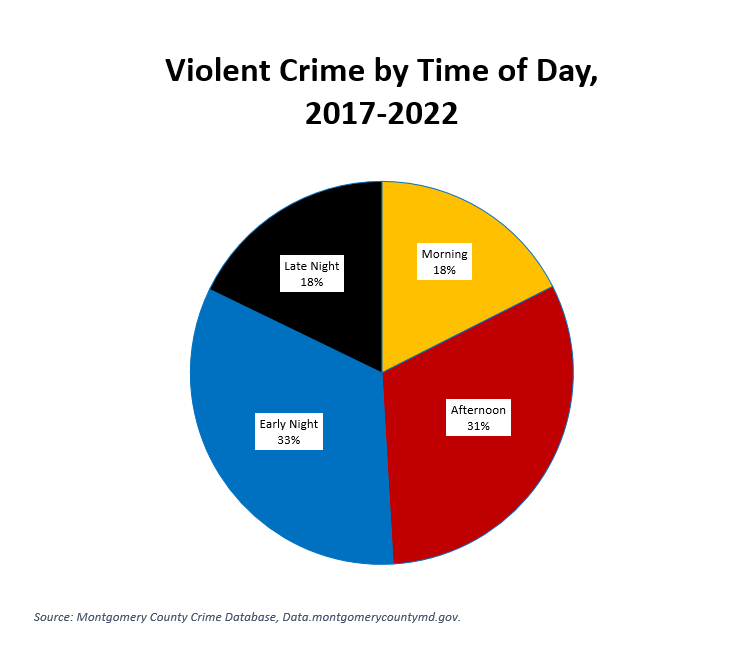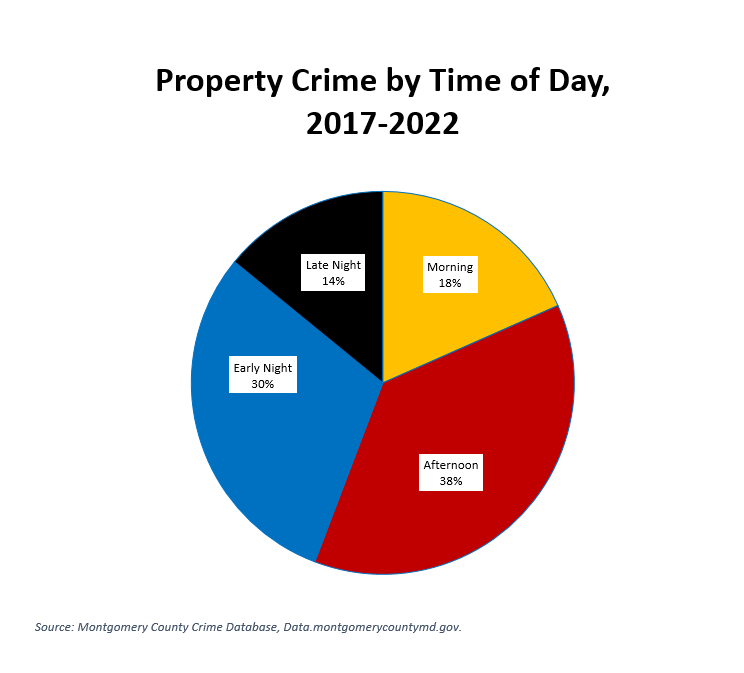By Adam Pagnucco.
Last month, county officials celebrated the passage of legislation intended to enhance late night safety. The bill requires some late night businesses to draft safety plans for approval by the police department on the premise that such plans would cut down on crime. Council Member Kate Stewart, who represents Downtown Silver Spring, said, “I know what’s most important to all of us is how we feel in our community… And making sure that when we go out at night, when our children go out, when our families go out, that we feel safe in our community. And that is the step we are taking today.”
The bill may be good public relations, but it will do little or nothing to affect crime. Why do I say that?
Consider these four facts.
Most crime does not take place after midnight.
In my series titled “A Time for Crime,” I analyzed the hours of the day in which crime occurs in the county. The pie charts below show those results for violent crime and property crime.


So only 14-18% of crime takes place between the hours of midnight and 6 AM, which was the original focus of the bill. (That focus has narrowed as detailed below.) I can’t tell how many of these crimes are related to business operations, but it’s probably a minority of them. So at its maximum potential scope, this bill was never going to impact the huge majority of crime in the county.
The bill has limited business coverage.
The bill was amended to apply to two types of businesses. It defines a covered business as one that “is open to the public at any time between 2:00 AM and 5:00 AM; or is open to the public at any time between midnight and 5:00 AM and, within the previous 12 months, has been the subject of 2 or more service calls for law enforcement regarding alleged serious incidents occurring on the premises.”
Most county alcohol licenses limit the hours of sale to 2 AM during the week with some allowing 3 AM on weekends. The language above would greatly limit the number of businesses who must comply. How many of them besides hookah bars operate after 2 AM? And in reference to Council Member Stewart’s statement above, how many children and families are out on the street after 2 AM? The bill is almost guaranteed to have minimal impact.
The bill won’t be implemented for many months.
The bill’s language states:
Sec. 2. Implementation. The [Police] Department must promulgate and submit proposed regulations to the Council for review within 180 days after this Act becomes law. Within 90 days after notice of the approved regulations is published in the County Register, each late night business must submit a proposed late night business safety plan to the Department for review. The County Executive should make a good faith attempt to notify each affected late night business of its obligation to submit a proposed safety plan.
So if the police department writes regulations in a timely fashion, and if the council approves them in a timely fashion, and if the executive branch identifies covered businesses and communicates with them in a timely fashion – all very big ifs – it will take longer than nine months to implement. Forget about this summer and maybe even next summer too.
The police department is still hamstrung by staffing problems.
I have written previously about the police department’s immense staffing problems. Resignations, retirements, vacancies and rising call response times are all serious issues. County Executive Marc Elrich’s recommended police budget contained a net service reduction and a decline in patrol positions. In its approved budget, the county council added three civilian firearm instructors, four crossing guards and a wellness manager, none of which are relevant to crime on the street.
Assistant Chief Administrative Officer Earl Stoddard told us that rebuilding the police department from the days when county leaders were all about defunding it would take a long time because of “the realities of a large number of existing vacancies and the long lead time to train and deploy new officers.” He is right about that. The county’s bonus program may turn out to be a good thing. But until the county resolves its officer labor shortage, no amount of paperwork required from businesses will have any significant impact on crime.
